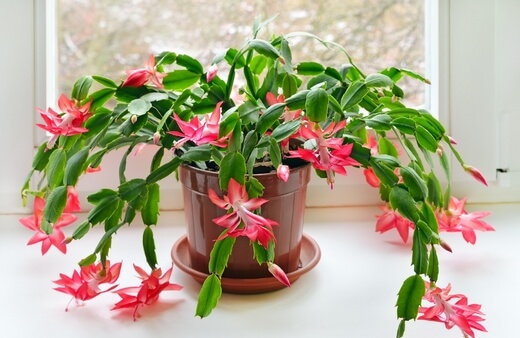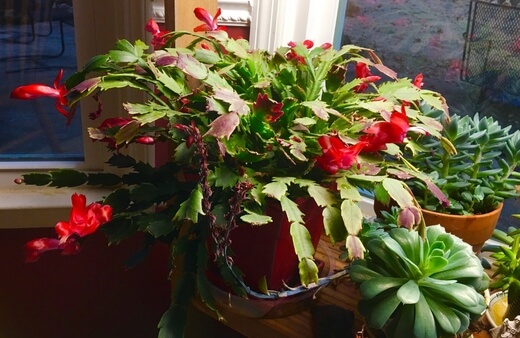I was once given a Zygocactus and it really is the gift that keeps on giving (or blooming should I say). It apparently can live for up to 100 years if well cared for so here’s to me doing my best to keep it alive for future generations!
In our how to grow guide, we’ll introduce you to the Zygocactus and then move on to how to propagate your own. We’ll share how best to care for your Christmas cactus, pests and diseases to be on the lookout for, and some frequently asked questions.
More...

Family: | Cactaceae |
|---|---|
Genus: | Schlumbergera |
Species: | truncata |
Common Names: | Holiday, Thanksgiving or Christmas cactus |
Location: | Indoor or outdoor |
Type: | Succulent |
Growth: | Up to 30 cm tall and 60 cm wide |
Sun requirements: | Bright and indirect light |
Foliage Colour: | Green |
Flower Colour: | Pink, pinky white, red, purple, orange and cerise |
Flowering: | Late Autumn to early Spring |
Fruit: | None |
Maintenance level: | Average |
Poisonous for pets: | No |
Introducing Zygocactus

When shopping for the Zygocactus, you might find it under the name Holiday cactus, Thanksgiving cactus, or the Christmas cactus. The names present a kind of theme but you might wonder what each of these mean, especially if they are sometimes grouped together under the Zygocactus name.
They do, after all, belong to the same Schlumbergera genus and they also look alike. The main differentiating factor is the period in which the plant blooms. The Christmas cactus for example, flowers in December in the America's and that is why it is known as the Christmas cactus.
Christmas Cactus Plant Features
The Zygocactus is a tropical succulent – the leaves are fleshy and green and then have stems which reach out, holding the flowers on their tip. The flowers of this succulent usually bloom around late Autumn to early Spring.
However, Zygocactus isn't a real cactus – the kind that we usually find living in the desert. It is native to South America where it calls the jungle its home, living in moist soil. As far as succulents go, this one is not drought tolerant.
How to Grow Zygocactus in Australia

Propagating Zygocactus
We always recommend when you take a plant cutting, that you first sterilise your secateurs or whatever implement you are using to do the cutting. This will help make sure you don’t spread any kind of disease to any existing plant or the cuttings that you are taking.
You can soak some cotton wool in alcohol and use this to do the cleaning. When you are ready to take your cutting, make sure that it has at least 3 leaf segments on it and make the cut where you see 2 leaf segments meet each other. You can then divide the cutting you have taken into smaller pieces.
Once you have your cuttings ready, you then need to let them callous. This usually needs a few days. You can place them in a dry place and make sure they are not directly in the sun. The reason you do this is because the cuts on the cuttings are at high risk for rotting until they form a callous.
Planting Christmas Cactus
You might be tempted to plant your Zygocactus cuttings in a large pot to allow for growth. You can in fact start with a smaller pot and then repot as they grow but just be extra careful as the segments are very fragile.
When planning your pot size, just remember that the Christmas cactus does like to be root bound at full size. Adding the right soil to your pot is important. Since Zygocactus is actually a succulent, you’ll need to make sure the soil has good drainage otherwise you might end up with root rot.
Any well-draining potting mix is fine and if you want to select one that is made for succulents that is perfect too. You can fill your pot and leave about 2.5 cm open at the top. Water the soil until it’s damp but it shouldn’t be soaked.
You can plant a few cuttings close together and when planting the segments, make sure the soil covers up just over a centimetre above the node, to allow for new root development.
Once planting is done, you can put the pot in a place that gets bright and indirect sun. You might notice that the cuttings start to look wilted – this is completely normal.


Get Your Free Guide:
Master Growing Australian Natives eBook
A Must Have Complete Guide for Every Australian Garden
Get Your Free Guide:
Master Growing Australian Natives eBook
A Must Have Complete Guide for Every Australian Garden
Only water the cuttings again when the top of the soil is dry. This is a great way to guide your watering schedule as the roots develop and establish themselves. It takes a month for new growth to become visible and these might have a reddish colour.
Zygocactus Care Guide

Light and Temperature Preference
The Zygocactus needs plenty of bright indirect light to be happy. They like warmth and a comfortable even temperature. You can grow the Christmas cactus outside if the temperatures don't drop too low.
A good outdoor spot for planting would be under a tree so they are not directly in the sun. Some gardeners like to move their Zygocactus outside for the summer months and then when the weather gets cooler, bring them indoors again. Cold and frost are not friends of this succulent.
Watering Needs
When thinking about a watering schedule for the Zygocactus, remind yourself that you are dealing with a tropical plant. That means a good deep watering when you do give it water, and then let it dry out before you water again.
The roots of the Christmas cactus should never be sitting in water. Here’s another tip – this plant likes humidity. If you don’t live in a place that provides enough, you can put your potted Zygocactus on a plate that is filled up with pebbles and water.
Best Soil for Christmas Cactus
Imagine where the Zygocactus grows in nature – it isn’t necessarily in soil as we know it. They grow in tree cracks or rock indentations where you might find natural debris. You can aim for something similar when choosing a potting mix, and be sure that it’s well-draining.
Fertiliser
Your Christmas cactus will enjoy a recommended houseplant fertiliser to help support any new growth. Wait until the plant is finished flowering. When you start seeing new leaf segments, you can start with your fertiliser and do this every few weeks.
As a guideline, in the active flowering phase, you can give it fertiliser once per month.
Possible Christmas Cactus Pests and Diseases
Blossom drop
The Zygocactus might experience blossom drop if it becomes stressed. Things like light and rapid changes in temperature could be the cause. Perhaps the soil has become too dry while the plant is in the growing phase.
Mealy Bugs
Mealy bugs love a warm climate to grow in. These pests usually look like a mass of white cotton on your plant leaves and stems. Mealy bugs particularly enjoy plants that have high nitrogen levels.
They can be attracted to your Zygocactus if you are giving it too much water and/or fertiliser. If you’re dealing with a light infestation, you can use some rubbing alcohol and water on a cotton bud to wipe them off the plant and kill them off.
Root Rot
If your Christmas cactus has root rot, you might notice it has slow growth. The stems might be mushy and the leaves can be wilted, yellow or start to look distorted. You might smell rotten soil and the roots become a red brown colour.
You’ll need to remove the plant from its pot and remove all soil from the roots. Cut away any rotten roots and prune the affected leaves and stems. You must throw out the affected soil and wash the pot with bleach water. This will kill off any fungus and bacteria.
Zygocactus Frequently Asked Questions

How long can a Zygocactus live for?
These amazing succulents have been known to live up to 100 years.
For more succulents, see our list of popular succulents in Australia.
What is the best time to move a Christmas cactus into the dark?
Towards the end of September or at the start of October. You can put your plant in a dark room or cover it up with a box or bag. Make sure it remains covered for at least 12 hours daily.
Would it be better to water my Zygocactus from the top or bottom?
Our advice is to water your plant from the bottom. This is the perfect way to make sure your plant is getting sufficient water as it can soak it up into its roots.
How long does a Zygocactus bloom for?
The plant can remain in flower mode for between 4 to 6 weeks. The flowers themselves can last up to 9 days each.
What is the best way to get my Zygocactus to bloom?
You can put your plant in a dark cupboard for 14 hours at night and start with this process about 8 weeks before you want blooming to begin. During the daytime you can bring it back out to bright light. When you start seeing the formation of buds, you can then stop with the night time dark cupboard process.
What is the difference between a Zygocactus and a Christmas cactus?
The only real difference between these two plants is their leaves. Christmas cactus leaves are smooth on the edges and zygocactus has jagged leaves.
When should I repot my Zygocactus?
These plants live for a long time which means you’ll probably be doing a few repotting sessions in the time that the plant is alive. Zygocactus actually likes to be a bit root bound in its pot so a snug fit isn’t a problem.
Ultimately though, they will eventually need space for their roots to grow. A good guideline is to repot your Christmas cactus every 3 years. Try and do this during their active growth period which would be springtime or at the beginning of summer.
Looking for more plants associated with Christmas? Take at look at NSW Christmas bush and NZ Christmas bush to bring more colour to your garden.
We love all things gardening. Looking for more advice and inspiration? Sign up for our newsletter.Wrapping Up Our Zygocactus Growing and Care Guide
A plant that blooms in time for the holidays sounds like something I want in my garden. They look and feel festive with their pretty leaves and vibrant flowers. Not sure what to get someone as a gift? I would say a Zygocactus is a great way to go. I’m giving this succulent my green thumbs up.
Published on January 20, 2023 by Gary Clarke
Last Updated on February 22, 2025





very informative guide thanks
Hi Elaine,
Thanks for the feedback. We really appreciate it.
Happy gardening!
Gary Clarke
thankyou, very helpful
Hi Lyn,
You’re welcome! If you have any more questions or need further assistance, feel free to ask.
Happy gardening!
I've just come out of a harrowing time in hospital. I am not able to even w walk around my garden(?) anymore and had given up on being able to potter around in it again.
I received a postal notification of a parcel to collect and when I opened it, it was 4 little Christmas Cacti that Is obviously ordered well in advance.
The article on how to care for these treasures has generated new enthusiasm and I can't wait to put up my new arrivals and concentrate on indoor plants and pots.
Thank you for reigniting my passion for growing things, even if in a limited capacity.
Happy gardening
Lesley Scott- Smith Rosedale Vic.